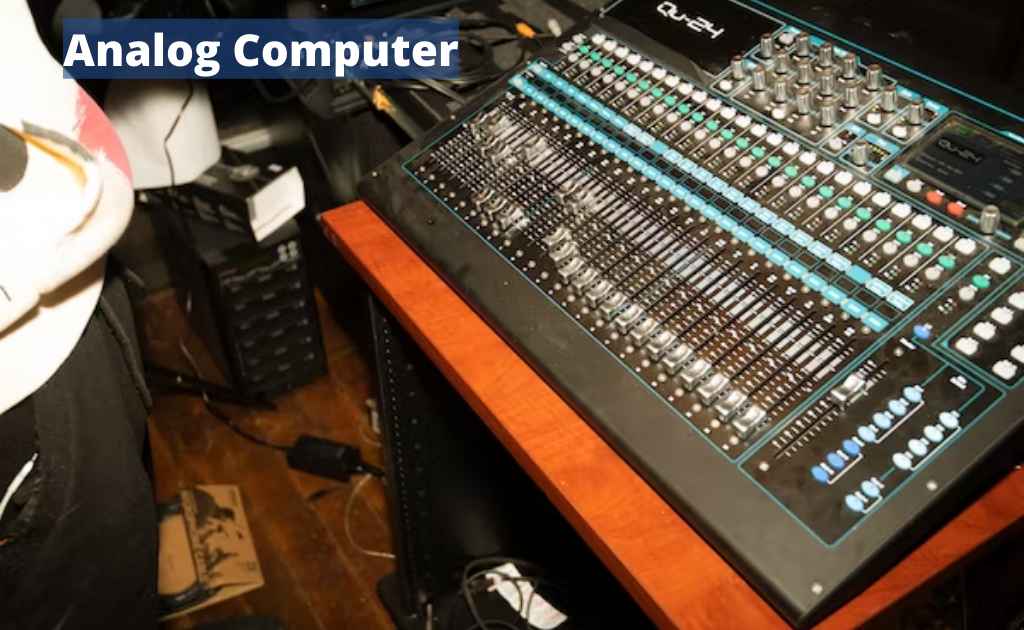Analog Computer – Types, Advantages, and Disadvantages
Analog computers have played a significant role in the history of computing technology. Unlike digital computers, which process discrete values, analog computers operate with continuous physical quantities like electrical voltage or mechanical motion. These machines are specifically designed to simulate physical systems and solve complex mathematical equations by using the inherent properties of their components.
Analog computers are devices that use electrical signals to perform calculations instead of using binary numbers. These types of computers were first invented in the 1940s and have been used in many different industries.

Analog computers are usually slower than digital computers because they require a large number of calculations to perform simple tasks. They also tend to be less reliable and accurate. However, they are easier to program and control.
Definition
An analog computer uses continuous variables such as voltage or current to represent numbers. Digital computers store information using discrete values, such as 0 or 1.
Analog computers are devices that perform mathematical calculations using electrical signals instead of binary digits (bits). They are also known as analog computers or electronic analog computers.
Basic Principles of Operation
Analog computers operate on the principle of using physical analogs to solve problems. They are designed to create physical representations of the problems they are solving, such as using electrical components to mimic mathematical relationships in differential equations.
This allows the computer to transform the problem into a physical system that corresponds to the solution of the original problem.
How Analog Computers Work
Understanding the operation of analog computers requires familiarity with their basic components and principles of analog computation.
Basic Components
The core components of an electronic analog computer typically include:
- Operational Amplifiers: These are the workhorses of electronic analog computers, used for various mathematical operations.
- Potentiometers: Used for setting initial conditions and scaling factors.
- Capacitors: Employed for integration operations.
- Resistors: Used in various circuits for scaling and other operations.
- Function Generators: Produce specific waveforms needed for certain calculations.
- Multipliers: Perform multiplication of signals.
Principles of Analog Computation
Analog computation is based on the principle of creating electrical (or mechanical) analogs of mathematical operations. For instance:
- Addition is performed by combining currents or voltages.
- Multiplication is achieved through special multiplier circuits or by using logarithmic converters.
- Integration is done using capacitors in feedback loops with operational amplifiers.
- Differentiation, though less common due to noise sensitivity, can be performed using specific RC circuits.
Signal Processing in Analog Computers
In analog computers, signals are continuous and represent the variables in the problem being solved. These signals are processed in real-time, with the computer’s output continuously changing as the input changes. This continuous nature allows for real-time simulation of dynamic systems, making analog computers particularly useful for certain types of problems.
History of Analog Computers
The history of analog computers spans centuries, with roots reaching back to ancient civilizations and continuing to evolve into the modern era.
Early Inventions
The Castle Clock, created by Al-Jazari in 1206, predates the slide rule and is an early example of an analog computing device. This complex water clock featured various mechanisms to display zodiac signs, and lunar and solar orbits, and even had programmable music automata, demonstrating early concepts of analog computation.
Evolution and Development
During the 19th and early 20th centuries, there were important developments in analog computing. For example, in 1872, James Thomson created the mechanical integrator, which played a key role in the development of future analog computers.
Additionally, in 1876, Lord Kelvin invented a tide-predicting machine that used a system of pulleys and wires to calculate tide levels based on specific times, locations, and moon positions. These advancements laid the foundation for the progress of analog computing during this period.
Key Inventors and Their Contributions
Several inventors and engineers made significant contributions to the field of analog computing:
- John V. Atanasoff: Although best known for his work on digital computers, Atanasoff also made contributions to analog computing, including a device for analyzing surface geometry.
- Charles Babbage: While famous for his work on digital computing concepts, Babbage also developed analog devices, including the Difference Engine.
- Vannevar Bush: His work on the differential analyzer was groundbreaking and influenced future developments in both analog and digital computing.
- George Philbrick: He played a crucial role in developing electronic analog computers, particularly in the field of operational amplifiers.
Types of Analog Computer
There are different types of analog computers which are given below:
Mechanical Analog Computers
These computers utilize mechanical parts such as gears, shafts, and levers to carry out complex calculations. Notable examples of these machines include the planimeter, which calculates areas, the slide rule for performing various mathematical operations, and the Antikythera mechanism, an ancient Greek device used for astronomical calculations.
Differential Analyzer
Differential analyzers are a specialized form of mechanical analog computers that are specifically designed to solve differential equations. Differential analyzers measure the difference between two signals.
These machines use wheel-and-disc mechanisms known as integrators to carry out the crucial operation of integration required for solving these equations. Bush’s differential analyzer at MIT was a significant milestone within this category of computing technology.
These instruments were first developed in the 1930s and have been widely used. Differential analyzers are used to measure small differences in voltage, current, frequency, phase angle, etc.
Electronic Analog Computers
An electronic analog computer is a device that performs mathematical calculations based on electrical signals. In contrast to digital computers, where information is represented by 0s and 1s, analog computers use continuous values.
Electronic analog computers are similar to their mechanical counterparts except they do not require any moving parts. Instead, they rely on electric currents to represent numerical data.
Electronic analog computers from the mid-20th century used electrical circuits with components like operational amplifiers, capacitors, and resistors to simulate mathematical and physical problems.
They were often used to solve differential equations and simulate dynamic systems by performing operations like addition, multiplication, and integration.
Hydraulic Analog Computer
Hydraulic analog computers are designed to perform complex mathematical operations. They consist of a series of valves that control the flow of water. As the valve opens or closes, the water flowing through the system changes. This change in volume causes a corresponding change in pressure. Pressure sensors detect these changes in pressure and convert them into numerical values.
These computers utilize fluid dynamics to symbolize data and conduct computations. An important instance is the MONIAC (Monetary National Income Analogue Computer), created by Bill Phillips in 1949, which employed colored water to simulate the national economic operations of the United Kingdom.
Slide Rule
A slide rule is a mechanical calculator invented by John Napier in 1614. A slide rule consists of two parallel scales, each divided into 100 equal parts. One scale represents the numerator and the other represents the denominator. By sliding the rule along its edge, the user can multiply or divide numbers.
The Castle Clock
The castle clock was invented by James Watt in 1765. It measures time using pendulums that swing back and forth at different rates depending on the pendulum’s length. The longer the pendulum, the slower the rate of oscillation. The faster the pendulum swings, the faster the rate of oscillation, and thus the shorter the period of oscillation.
Advantages of Analog Computer
Despite being largely superseded by digital computers, analog computers possess several unique advantages:
Speed for Certain Calculations
Analog computers have a special advantage over digital computers in that they can solve specific problems, such as differential equations, much faster. This is because they perform calculations in real-time, without the limitations of digital processing speed, and instead rely on the rapid propagation of electrical signals through their circuits.
Continuous Data Processing
Analog computers operate with continuous signals, as opposed to digital computers which discretize data. This characteristic makes analog computers well-suited for simulating physical systems that are inherently continuous, like fluid dynamics or electrical systems.
Real-time Output
Analog computation provides real-time output, which is particularly beneficial for applications such as flight simulators or process control systems due to the continuous and immediate availability of results.
Simplicity in Design for Specific Tasks
Analog computers can be much simpler in design than digital computers for certain specialized tasks. This simplicity often results in greater reliability and ease of understanding for specific applications.
Disadvantages of Analog Computer
Analog computers, despite their advantages, have experienced a decline in favor of digital systems due to their several limitations.
1: Limited Accuracy
Analog computers are limited in accuracy by the precision of their physical components. Elements such as electrical noise, component tolerances, and thermal drift can impact the accuracy of calculations.
2: Difficulty in Storing Results
Analog computers encounter challenges in storing and retrieving data because they operate continuously, which makes it difficult to capture and store results for later use. In contrast, digital computers can easily store and retrieve precise numerical values.
3: Size and Power Consumption
Analog computers, especially those designed for complex calculations, often require a large amount of space and consume significant amounts of power, especially older, vacuum tube-based systems.
4: Limited Programmability
Analog computers are highly effective at solving certain types of problems, but they lack the flexibility and ease of programmability that digital computers offer. Adjusting the function of an analog computer typically entails physically reconfiguring its components.
Applications of Analog Computers
Throughout their history, analog computers have found applications in various fields:
Historical Applications
Ballistics Calculations: During World War II, analog computers were extensively used for calculating artillery firing tables.
- Aircraft Design: Analog computers played a crucial role in simulating aircraft behavior for design and testing purposes.
- Control Systems: They were used in industrial process control and in the design of control systems for various applications.
- Scientific Research: Analog computers aided in solving complex equations in fields like physics and engineering.
Modern Use Cases
While less common, analog computers still find use in specific areas:
- Education: They are used to demonstrate principles of calculus and dynamic systems.
- Audio Processing: Some high-end audio equipment uses analog computing principles for sound processing.
- Neural Networks: Certain types of artificial neural networks can be implemented using analog circuits.
Potential Future Applications
As technology continues to advance, we are seeing new potential applications for analog computing emerge. These include quantum-inspired computing, which could simulate quantum effects for specific calculations, as well as neuromorphic computing that mimics biological neural networks for AI applications. Additionally, low-power analog computation is being considered for edge computing in IoT devices to preprocess sensor data.
Relevance of Analog Computers in the Digital Age
While digital computers dominate the computing landscape, analog computers maintain relevance in certain areas:
Niche Applications
Some specialized fields still benefit from the unique properties of analog computation. For instance, certain scientific instruments and control systems continue to use analog components for their real-time processing capabilities.
Research and Development in Analog-Digital Hybrid Systems
There’s growing interest in hybrid systems that combine the strengths of both analog and digital computation. These systems could potentially offer the speed and efficiency of analog processing with the precision and flexibility of digital systems.
Emerging Technologies and Potential Innovations
The principles of analog computing are finding new applications in cutting-edge technologies:
- Analog AI: Researchers are exploring analog implementations of neural networks that could be more energy-efficient than their digital counterparts.
- Quantum Annealing: Some quantum computing approaches, like those used by D-Wave Systems, have parallels with analog computation.
- Biological Computing: There’s growing interest in using biological systems for computation, which often operate in an analog manner.







Leave a Reply